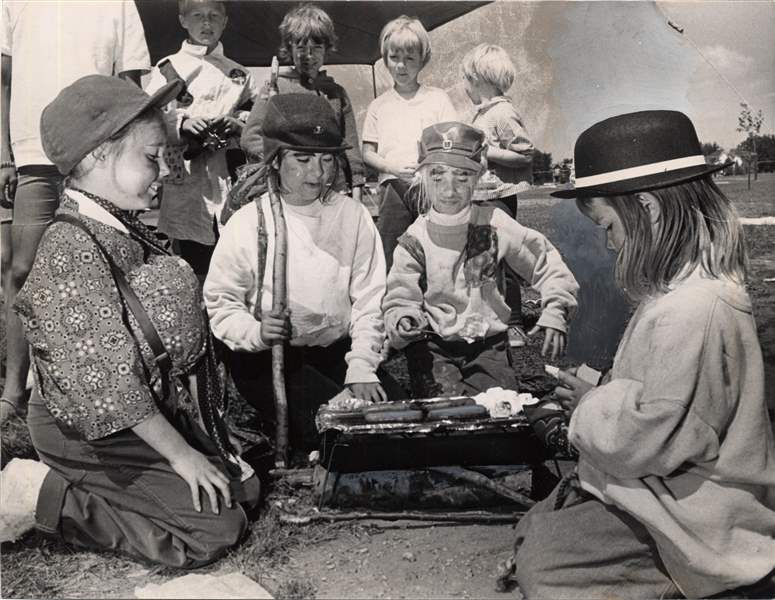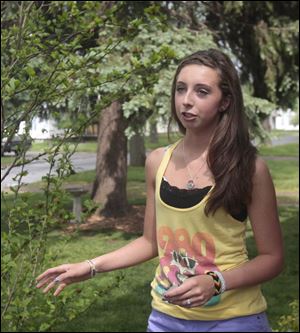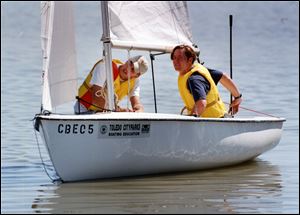
Recreation programs’ heyday past
5/6/2012
Friendship Park held annual hobo parties, such as this one in 1967.
Blade file photo

Celina Dusseau, 16, of Point Place remembers childhood fun activities at Friendship Park.
Sailing classes, mobile tennis clinics, puppet workshops, nature camps.
The city of Toledo formerly offered its residents all of these programs and more, often at no or low cost. But after years of budget cuts hastened by the economic downturn, such wide-ranging recreational opportunities seem almost unimaginable now.
Today, Toledo's recreation budget is less than a third of what it was a decade ago, accounting for inflation. During the mid-1990s, a heyday for recreation in the city, program funding was six times what it is now. This year's recreation budget, just over $900,000, is by far the lowest in at least 30 years, according to figures provided by the city.
Councilmen Lindsay Webb and Steven Steel want to change that and start reinvesting in recreation. They have been exploring ways to counter the cuts in recreation spending, holding meetings in recent weeks with residents and representatives of schools, nonprofit organizations, and other community groups. All options are being considered, but the one that seems most viable is putting a recreation levy on the November ballot, they said.
The city's drastic cuts for recreation have not gone unnoticed by residents, some of whom now go outside the city to find programs for their children. Those who remember the good old days of plentiful offerings lament what time and budget pressures have taken away.
Community reaction
Jo-Lynn White, 44, who grew up in the central city, remembers going to nearby parks in the summer to take part in free arts and crafts activities, team sports, and tennis classes. Now, parents like her have to pay for private summer camps and travel to find recreational options if they can afford to, she said.

"You could always go to the park and there was always something at the park" she recalled of her childhood. "Anything you wanted to do, literally, you could learn how to do it in the summer."
Point Place resident Celina Dusseau remembers the fun she had at city-run summer activities in nearby Friendship Park when she was younger. Now 16, Celina said she looked into volunteering for one of the park programs she used to attend, only to find out they no longer exist.
"It was disappointing," she said. "I wanted to be able to do that with the kids in the neighborhood. … It was such a big part of my childhood."
The decline in recreation programs, along with misgivings about local public schools, have driven many families out of her neighborhood, said Celina, who attends high school in Monroe, where she plays tennis after school. "Unfortunately, the city's offering less and less for every age group. It seems like it's all retired people here now," she said. "It used to be such a family-oriented city and it no longer is."
A possible remedy
The possible tax that Councilmen Webb and Steel are considering probably would be for 1 mill, raising $3 million a year. The tax would cost the owner of a $60,000 home in Toledo -- the average house value in the city, Ms. Webb said -- about $18 a year. Public debate on the new tax would start in June, and paperwork to get the levy on the November ballot would be due in early August, Ms. Webb said.
Jen Sorgenfrei, spokesman for Mayor Mike Bell, said the administration would not oppose council's efforts to put a tax question on the ballot to pay for recreation programs.
A tax proposal would allow residents a voice in determining the city's priorities.
Noticeable losses
Woody Woodward, executive director at the Ohio Parks and Recreation Association, said that during a visit here just more than a week ago, he was taken aback by the poor state of the city's recreational facilities and programming.
"I've seen municipal recreation departments all over the state, seen the conditions of facilities, and it is very clear that Toledo has not invested in their parks and recreation programs at a level that is probably commensurate with what other cities are expending throughout Ohio," he said. "It almost feels like, at some point, parks and recreation ceased to be a priority … The result is a system that is really crying out for some attention."
City-run recreation activities haven't disappeared entirely. Toledo continues to organize one-day special events in some parks, such as an Egg Extravaganza in Ottawa Park during the Easter season, a Kid's Fishing Rodeo in mid-July, and a summer concert series in Ottawa Park. Several athletic leagues also use city-owned facilities for sports programs such as baseball, basketball, boxing, and hockey.
In all, more than 104,000 people participated in athletic programs and events in 2011 at Toledo's recreational facilities, according to figures provided by Denny Garvin, commissioner of parks, recreation, and forestry. These include events held at the Friendship Park Community Center in Point Place and admission to city swimming pools and to the Ottawa Park Ice Rink.
But one look at Toledo's recreation programming from the 1980s and 1990s is enough to highlight just how much city-funded opportunities for children and adults have diminished. A 1988 listing of summer programs in The Blade detailed summer-long, full-day recreational day camps at three city parks which, for $20 every two weeks, included activities such as tennis, T-ball, volleyball, field trips, and workshops on magic, puppetry, and clowning. Children also could participate in a week-long nature camp for $10 (about $19 in today's money).
A changing story
A 1992 listing of programs includes courses in sailing, power boating, and canoeing for adults and families.

Toledo’s recreation programming in the 1990s included sailing lessons near Walbridge Park and puppet shows at Mayfair Park in West Toledo.
Greg Holewinski, director of Friendship Park Community Center, recalled some of these programs and others from his early years as a city employee. Hired straight out of college in 1984 as a playground supervisor, Mr. Holewinski said he and other young hires were charged with organizing free activities for children at parks throughout the city from mid-June to mid-August.
"It was great. It gave the kids an opportunity to have organized recreation in the park -- kickball, baseball. They'd look forward to it," he said. "They'd just come over in the morning and we'd figure out what they wanted to do."
Fast-forward to the late 1990s and through today, and the story changes dramatically, he said.
"It's terrible. It seems like every year we're fighting to figure out if we're going to have jobs or not," he said. "I used to get layoff notices every year, then they'd be rescinded, then they'd partially fund this or that … This went on for years."
Mr. Garvin, who took over responsibility for the city's recreation division this year from the Department of Neighborhoods, said the most debilitating issue affecting programs since he became a city employee in 1984 has been a drastic reduction in staff. Today, the recreation division has eight full-time employees, he said. That's fewer people than the city employed in just one area -- boating and nature education -- which he oversaw until the programs were defunded in the mid-2000s.
Impact on youth
Councilmen Webb and Steel voice concerns that people will leave Toledo if public parks and recreation are not improved. They and others also fear that lack of accessible recreation options for the city's youth could be a factor in increased gang activity and violent crime.

Friendship Park held annual hobo parties, such as this one in 1967.
That analysis holds true for Morris Jenkins, chairman of criminal justice and social work at the University of Toledo.
"Ever since I've been here, there's been fewer and fewer [recreation programs]," he said. "I think with the older adolescents, you'll see kids getting into activities that they shouldn't be getting into. And I think with the younger ones, it impacts what they do in school."
Major Smith, 17, who lives in the central city, said he's seen negative effects from lack of recreational opportunities among youths in his neighborhood and in his own family, although he's tried to avoid negative influences himself. Some youths get involved in gangs because they have nothing better to do, he said. "They're just kids that are looking for a way. They just have nowhere to be, nothing to do," he said. "They're just lost."
If Councilmen Webb and Steel move ahead with the levy idea, the money would be put into its own fund and directed exclusively toward parks and recreation.
Other communities close to Toledo and across Ohio have adopted similar systems, officials said.
"We owe it to our community to have this conversation," Ms. Webb said. "Based on what I'm hearing from around the country, communities that do not have dedicated funding streams for parks and recreation find they have no parks and recreation."
Contact Claudia Boyd-Barrett at cbarrett@theblade.com or 419-724-6272.